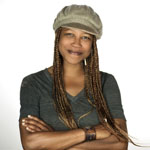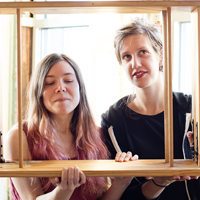Permaculture Takes Root in the WestCo Courtyard
TO WILD WES, ‘LANDSCAPE’ MEANS ‘NATURAL’ BY YAEL CHANOFF ’11
From the top of Foss Hill, the view of Wesleyan is a picture of New England college charm. But in the green expanses of lawn, where most see tradition and classic beauty, some Wesleyan students see an environmental affront.
Look toward the WestCo courtyard, however, and you will see a field of dirt where a student group, WILD Wes (Working for Intelligent Landscape Design), is trying an alternative approach to landscaping. With Wesleyan’s support, WILD Wes has embarked on a bold experiment: ditch the lawn and replace it with a sustainable landscape, based on the principles of permaculture.
Permaculture design is meant to mimic natural patterns, such that the systems thrive permanently on their own, with low human maintenance. Wesleyan Head of Grounds Dave Hall believes the WestCo site has the potential to reach this level. “I’m hoping that it becomes labor-neutral,” he says. “There’s the possibility of some handwork, but no machinery.”
New York Times writer Michael Tortorello described permaculture as “a growing and influential movement that runs deep beneath sustainable farming and urban food gardening. You can find permacultur- ists setting up worm trays and bee boxes, aquaponics ponds and chicken roosts, composting toilets and rain barrels, solar panels and earth houses.”
The concepts of permaculture originated when farmers at the turn of the 20th century espoused the value of “permanent agriculture” to save the land from the indus- trial forest-field-plow-desert pattern that
produced quick results but left land barren. The movement picked up in the 1970s, and acquired a cultural dimension with alterna- tive commune-style living, “eco-villages,” and private residents experimenting in their own backyards. Now, permaculture has entered the mainstream, and WILD Wes has a hand in this new stage in the movement.
For Miles Bukiet ’11, co-founder of WILD Wes, “It’s a victory for permaculture and it’s a victory for Wesleyan. What this project represents is a coming of age of the permaculture movement.”
Tom Christopher, author of The New American Landscape: Leading Voices on the Future of Sustainable Gardening, believes that the university’s endorsement of the project represents a big step away from high-maintenance, unsustainable prac- tices, which use nearly 4,000 gallons of gas and diesel fuel per year, according to Wesleyan’s lawn service vendor. “The real change comes in deciding no, I’m not going to do it that way,” Christopher says. “I’m not going to prop up the thing with massive amounts of chemicals, and tons of fertilizers, and hundreds of thousands of gallons of drinking water sprayed all over it every summer.”
The courtyard is a challenging site. Years of erosion have swept away the top- soil, leaving the ground rocky and com- pact. Several large beech trees had to be removed in late May due to an epidemic of beech bark disease, essentially leaving the area devoid of any plant life other than the ailing lawn. Jokes Katie McConnell ’13, who led the project’s implementation last sum- mer, “We got assigned one of the places where it’s like, ‘Well, if you mess up it was pretty bad already, so—go for it!’” Bukiet acknowledges the difficulty of the task ahead: “Turning a highly eroded, steep bit of land into a productive, low maintenance system is not easy. And we’re all novices. But we’re determined to make it work.”
Their determination was on display in December 2011, when WILD Wes held its first annual Design Charrette, a symposium that brought together professional perma- culture designers, faculty and staff from Wesleyan, and students from the University of Massachusetts-Amherst to brainstorm ideas for sustainable landscaping on cam- pus. The next semester, spring 2011, Bukiet and WILD Wes co-founder Sam Silver ’11 taught a student forum, the Sustainable Landscape Design Studio, in which they developed practical plans for WestCo. They also won a $50,000 grant from the Green Fund, Wesleyan’s student-run resource for environmental initiatives on campus.
In the short term, the WestCo site won’t be pretty. But Joyce Topshe, associate vice president for facilities, has faith that the project will ultimately provide a pleasing result. “Every project at Wesleyan is scrutinized to be sure that it fits within the context of the campus,” she explains. “This means something aesthetically pleasing, economically viable, and sustainable. The WILD Wes students have demonstrated a very realistic approach to their proposals.”
Even in the courtyard’s current state, with its rocky ground dug up and no longer hid- den by sparse grass, the project’s exciting potential is clear. Last summer McConnell, upbeat despite having spent a blindingly hot morning swinging a pick-axe, explained, “Basically right now, I’m getting dirt ready.” The pick-axe was for constructing swales, low-level trenches across the contours in the land to collect water and curb erosion. Next, McConnell planned to begin sheet mulch- ing: layering compost, then cardboard as a biodegradable weed barrier, and then mulch on top of that [now done].
After rebuilding the soil, the site will be ready for planting this upcoming spring. WILD Wes is considering wildflowers, innova- tive sustainable lawns, and even edible fruit trees. Ned Phillips-Jones, a recent Hampshire College graduate who started a per- maculture food forest at his alma mater and now runs a sustainable landscape design business, has worked closely with the group and acted as a source of inspiration. Jones remembers when his garden was in its beginning stages, looking as desolate as the WestCo site. “Now it’s about four years from that point, and there are over 40 types of fruit crops and a lot of students go there to hang out and study. It’s a real place of learning,” says Jones, who believes the WestCo site could follow a similar path.
Emboldened by Wesleyan’s support, the students of WILD Wes are excited about the permaculture movement’s potential all over campus, and even beyond. Says Bukiet, “You could call people idealists who are involved in projects like this. But I think if you ask people in the group, we would call ourselves realists. We can start right here. We have to start right here.”
Bill Nelligan, Wesleyan’s director of sustainability, has confidence in the project. “It’s a great sustainable model. We will be creating landscapes across campus that are not only self-sufficient and native but will provide an edible landscape as well.”
Christopher is also optimistic about the project’s reach. He predicts that faced with environmental emergency, governments and businesses are going to have to create more sustainable designs. And when they do, “It’s going to be people working in the WestCo courtyard who are showing them the way.” PROFILES


